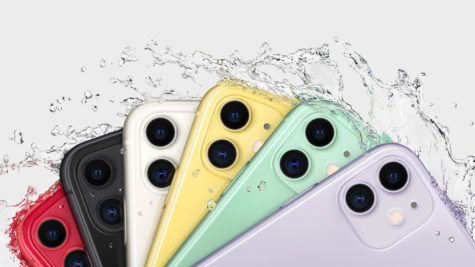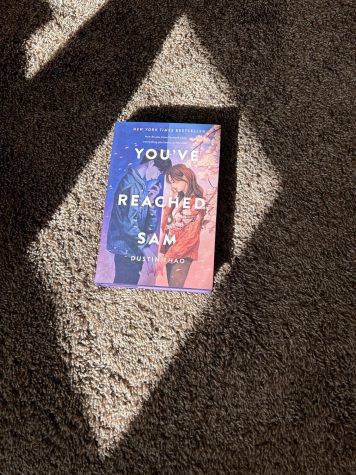Purchase or Pass: Here’s what you need to know about Apple’s newest iPhone Line-up
October 29, 2019

This photo showcases the iPhone 11’s many color options. The water around the devices is representative of the phone’s improved water resistance– four meters for up to 30 minutes for the 11 pro and two meters for up to 30 minutes for the 11.
Ever since Apple’s first crack at creating a revolutionary smartphone in 2007, the company has been dominating the market with its yearly installments of its flagship iPhones. With each year, fans await the release of each new edition, eager to see what new features and improvements will be added.
Last year’s iPhone XR, XS and XS Max were big hits, as said by Apple CEO Tim Cook at the Apple Special Event on Sept. 10.
“The iPhone XR became the most popular iPhone and the most popular smartphone in the world,” he said.
The iPhone XS and XS Max were the most advanced iPhones the company had ever created, and the three phones had a combined customer satisfaction rate of 99 percent- “the highest in the industry,” Cook said.
Following the success of their predecessors, the new iPhone 11 and 11 Pro were unveiled at the Apple Special Event, where the creators boasted of improved cameras, better battery life and the new A13 Bionic Chip.
At first glance, the user’s eye catches the iPhone’s new camera set up with a square bezel that encases the camera system and the triangular layout of the iPhone 11 pro’s triple-camera system.
The revised camera systems were without a doubt the most notable feature discussed at the special event, taking up about a third of the time of the iPhone 11 and 11 pro presentations.
The iPhone 11 has two cameras, one being a wide camera and the other an ultrawide camera that provides a 120-degree field of view. Both phones now have the new night mode, which activates automatically to vastly improve the quality of low-light photos.
“I didn’t expect the 11 to have wide angle photos. I thought only the pro would have it,” said Jocie Bank, senior, who received the iPhone 11 as a surprise from her mom. Her favorite feature of the phone is the night mode.
The iPhone 11 pro, on the other hand, is the first Apple smartphone to have three rear-facing cameras. This additional telephoto camera offers additional framing options and improves optical zoom range. This move was certainly necessary to stay competitive with other phone manufacturers, such as Samsung and LG, who also released triple camera phones this year.
“This is the first iPhone that we’ve had a camera system that we call pro, and it’s really worthy of this name,” said Phil Schiller, presenter of the iPhone 11 pro at the Apple Special Event.
Instructional Coach Melissa Sethna said that the camera was the main reason she opted to get the 11 pro rather than the 11 when it came time to upgrade. She has seen a vast improvement in video clarity, which will conveniently allow her to substitute her large camera with the phone.
“I’m just excited to not have to take two cameras on a vacation– that’s my thing,” Sethna said.
Aside from the significant changes to the camera, the iPhone 11 mirrors the look of the previous iPhone XR, which is made of aluminum and glass, with brand new colors reminiscent of the iPhone XS, but the 11 pro features stainless steel and glass construction– plus has a new midnight green version.
Additionally, the glass is claimed by Apple to be the most durable glass in a smartphone, and after viewing drop tests, the company’s claim seems to hold up well.
The internals of the phones also got an upgrade with the new A13 Bionic chip, which is a key element that makes the iPhone line unique.
“Now, at Apple, we have the benefit of the entire vertical stack– system hardware, software and chip,” said Sri Santhanam, vice president of Silicon Engineering, at the Apple Special Event. “We work together to optimize every block on the chip, all the way from the transistor up through the package design to work efficiently for iOS and iPhone.”
This new chip improves machine learning and tackles an issue many iPhone users have had in the past– a low battery life. The chip has an efficient low-power design that allows for great performance and is a key improvement that increased battery life dramatically in the iPhone 11 and 11 pro. The iPhone 11 pro has four hours more battery life than its predecessor, the iPhone XS.
Now for the real kicker– price. The iPhone 11 actually has a lower release price, starting at $699, than its predecessor the iPhone XR, which started at $749, an unusual change considering the vast changes that have been made. Of course, this lower price range will broaden the market for the phone and will allow more people the chance to buy it.
All things considered, I see the iPhone 11 as being a great option for those in need of an upgrade from a previous model or from another phone. It has a great range of colors, superb durability, improved battery life and a solid camera system. It’s price and features make it a great phone for anyone.
English Teacher Kristina Rizzo upgraded to the iPhone 11 from the iPhone 7 and is enjoying the new features despite the learning curve that went along with the switch.
“I’m also used to the phone scanning my thumbprint to unlock, so the face recognition is new for me. Also, without the home button, I had to figure out how to take a screenshot,” she said about some of the learning curves.
As far as the iPhone 11 pro goes, I’m unsure if the jump to $999 for the 5.8 inch model and $1,099 for the 6.5 inch model is worth it for the average consumer. The camera and size options are the most favorable features of the pro, but I find that unless you are interested in doing professional-level photography or need the larger screen size, I don’t know that the price is worth it.
What I can’t deny are the efforts made by Apple to keep pushing the boundaries of what a smartphone can do by setting the bar for performance. It is clear to see that competition in the smartphone industry has been driving prices down and is applying pressure on large companies like Apple to keep innovating. The iPhone 11 and 11 pro are evidence of this pressure to innovate in an ever-evolving market.





